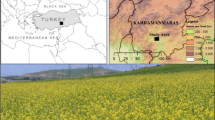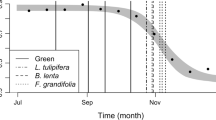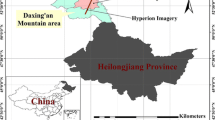Abstract
Spectral reflectance values of four canopy components (stems, buds, opening flowers, and postflowers of yellow starthistle (Centaurea solstitialis)) were measured to describe their spectral characteristics. We then physically combined these canopy components to simulate the flowering stage indicated by accumulated flower ratios (AFR) 10%, 40%, 70%, and 90%, respectively. Spectral dissimilarity and spectral angles were calculated to quantitatively identify spectral differences among canopy components and characteristic patterns of these flowering stages. This study demonstrated the ability of hyperspectral data to characterize canopy components, and identify different flowering stages. Stems had a typical spectral profile of green vegetation, which produced a spectral dissimilarity with three reproduction organs (buds, opening flowers, and postflowers). Quantitative differences between simulated flower stages depended on spectral regions and phenological stages examined. Using full-range canopy spectra, the initial flowering stage could be separated from the early peak, peak, and late flowering stages by three spectral regions, i.e. the blue absorption (around 480 nm) and red absorption (around 650 nm) regions and NIR plateau from 730 nm to 950 nm. For airborne CASI data, only the red absorption region and NIR plateau could be used to identify the flowering stages in the field. This study also revealed that the peak flowering stage was more easily recognized than any of the other three stages.
Similar content being viewed by others
References
Benefield, C. B., DiTomaso, J. M., Kyser, G. B., Orloff, S. B., Churches, K. R., Marcum, D. B. and Nader, G. A.: 1999, ‘Success of mowing to control yellow starthistle depends on timing and plant's branching form’, Cal. Agr. 53, 17–21.
Benefield, C. B., DiTomaso, J. M., Kyser, G. B. and Tschohl, A.: 2001, ‘Reproductive biology of yellow starthistle (Centaurea solstitialis): Maximizing late season control’, Weed Sci. 49, 83–90.
Chuine, I. and Beaubien, E. G.: 2001, ‘Phenology is a major determinant of tree species range’, Ecol. Let. 4, 500–510.
Clark, D. B., Carlomagno, S. C., Alvarado, A., Diego, L. and Read, J. M.: 2004a, ‘Quantifying mortality of tropical rain forest trees using high-spatial-resolution satellite data’, Ecol. Let. 7, 52–59.
Clark, D. B., Read, J. M., Clark, M. L., Cruz, A. M., Dotti, M. F. and Clark, D. A.: 2004b, ‘Application of 1-M and 4-M resolution satellite data to ecological studies of tropical rain forests’, Ecol. Appl. 14, 61–74.
Connett, J. F., Wilson, L. M., McCafferey, J. P. and Harmon, B. L.: 2001, ‘Phenological synchrony of Eustenopus villosus (Coleoptera: Curculionidae) with Centaurea solstitialis in Idaho’, Environ. Entomol. 30, 439–442.
DiTomaso, J. M.: 1997, ‘Risk analysis of various weed control methods’, Proc. Cal. Exotic Plant Pest Coun. 2, 61–64.
DiTomaso, J. M., Kyser, G. B. and Hasting, M. S.: 1999, ‘Prescribed burning for control of yellow starthistle (Centaurea solstitialis) and enhanced native plant diversity’, Weed Sci. 47, 233–242.
DiTomaso, J. M.: 2000, ‘Invasive weeds in rangelands: Species, impacts and management’, Weed Sci. 48, 255–265.
Jackson, R. B., Banner, J. L., Jobbagy, E. G., Pockman, W. T. and Wall, D. H.: 2002, ‘Ecosystem carbon loss with woody plant invasion of grasslands’, Nature 418, 623–626.
Kalkhan, M. and Stohlgren, T.: 2000, ‘Using multi-scale sampling and spatial cross-correlation to investigate patterns of plant species richness’, Environ. Mon. Assess 64, 591–605.
Kokaly, R. F., Anderson, G. L. Root, R. R. Brown, K. E., Mladinich, C. S., Hager, S. and Dudek, K. B.: 2002, ‘Mapping leafy spurge by identifying signatures of vegetation field spectra in Compact Airborne Spectrographic Imager (CASI) data’, Geol. Soc. Am. Abstr. 34, 552.
Lechowicz, M. J.: 2001, ‘Phenology. Encyclopedia of Global Environmental Change’ Volume 2. The Earth System: Biological and Ecological Dimensions of Global Environmental Change, Wiley, London.
Mack, M. and D'Antonio, C.: 1998, ‘Impacts of biological invasions on disturbance regimes’, Tren. Ecol. Evol. 13, 195–198.
Mack, R. N., Simberloff, D., Lonsdale, W. M., Evans, H., Clout, M. and Bazzaz, F.: 2000, ‘Biotic invasions: Causes, epidemiology, global consequences and control’, Ecol. Appl. 10, 689–710.
Mooney, H.: 1999, ‘The global invasive species program (GISP)’, Biol. Invasions 1, 97–98.
Peñuelas, J. and Filella, L.: 1998, ‘Visible and near-infrared reflectance techniques for diagnosing plant physiological status’, Trends Plant Sci. 3, 151–156.
Pimentel, D., Lach, L., Zuniga, R. and Morrison, D.: 2000, ‘Environmental and economic costs associated with non-indigenous species in the United States’, Bioscience 50, 53–65.
Pitcairn, M. J. and DiTomaso, J. M.: 2000, ‘Rangeland and uncultivated areas: integrating biological control agents and herbicides for starthistle control’, in: M. S. Hoddle (ed.), California Control on Biological Conference II., pp. 65–72.
Pitcairn, M. J., DiTomaso, J. M. and Fox, J.: 1999, ‘Integrating chemical and biological control methods for control of yellow starthistle’, in: D. M. Woods (ed.), Biological Control Program Annual Report, 1998. California Department of Food and Agriculture, Plant Health and Pest Prevention Services, Sacramento, CA, pp. 77–82.
Price, J. C.: 1994, ‘How unique are spectral signatures?’, Rem. Sens. Envir. 49, 181–186.
Silvestri, S., Marani, M., Settle, J., Benvenuto, F. and Marani, A.: 2002, ‘Salt marsh vegetation radiometry data analysis and scaling’, Rem. Sens. Envir. 80, 473–482.
Roché, C. T. and Thill, D. C.: 2001, ‘Biology of common crupina and yellow starthistle, two Mediterranean winter annual invaders in western North America’, Weed Sci. 49, 439–447.
Roché, C. T. and Roché, B. F.: 1988, ‘Distribution and amount of four knapweed (Centaurea L.) species in eastern Washington’, Nor. Sci. 68, 86–96.
Roché, C. T., Thill, D. C. and Shafii, B.: 1997, ‘Reproductive phenology in yellow starthistle (Centaurea solstitialis)’, Weed Sci. 45, 763–770.
Simberloff, D. and Stiling, P.: 1996, ‘How risky is biological control?’, Ecology 77, 1965–1974.
Simberloff, D.: 2001, ‘Biological invasions: How are they affecting us, and what can we do about them?’, West. Nor. Am. Nat. 61, 308–315.
Stohlgren, T. J., Falkner, M. B. and Schell, L. D.: 1995, ‘A modified-Whittaker nested vegetation sampling method’, Vegetatio 117, 113–121.
Thomsen, C. D., Vayssieres, M. P. and Williams, W. A.: 1994, ‘Grazing and moving management of yellow starthistle’, in: Proceeding of California Weed Conference 46, 228–230.
Thomsen, C. D., Williams, W. A., Olkowski, W. and Pratt, D.W.: 1996, ‘Grazing, mowing and clover plantings control yellow starthistle’, The IPM Prac. 18, 1–4.
Thomsen, C. D., Vayssieres, M. P. and Williams, W. A.: 1997, ‘Mowing and subclover plantings suppress yellow starthistle’, Cal. Agr. 51, 15–20.
Turner, W., Spectro, S., Gardiner, N., Fladeland, M., Sterling, E. and Sterninger, M.: 2003, ‘Remote sensing for biodiversity science and conservation’, Trends Ecol. Evol. 18, 306–314.
Wilcove, D. S., Rothstenm, D., Dubow, J., Phillips, A. and Losos, E.: 1998, ‘Quantifying threats to imperiled species in the United States’, Bioscience 48, 607–615.
Author information
Authors and Affiliations
Corresponding author
Rights and permissions
About this article
Cite this article
Ge, S., Everitt, J., Carruthers, R. et al. Hyperspectral Characteristics of Canopy Components and Structure for Phenological Assessment of an Invasive Weed. Environ Monit Assess 120, 109–126 (2006). https://doi.org/10.1007/s10661-005-9052-1
Received:
Accepted:
Published:
Issue Date:
DOI: https://doi.org/10.1007/s10661-005-9052-1




